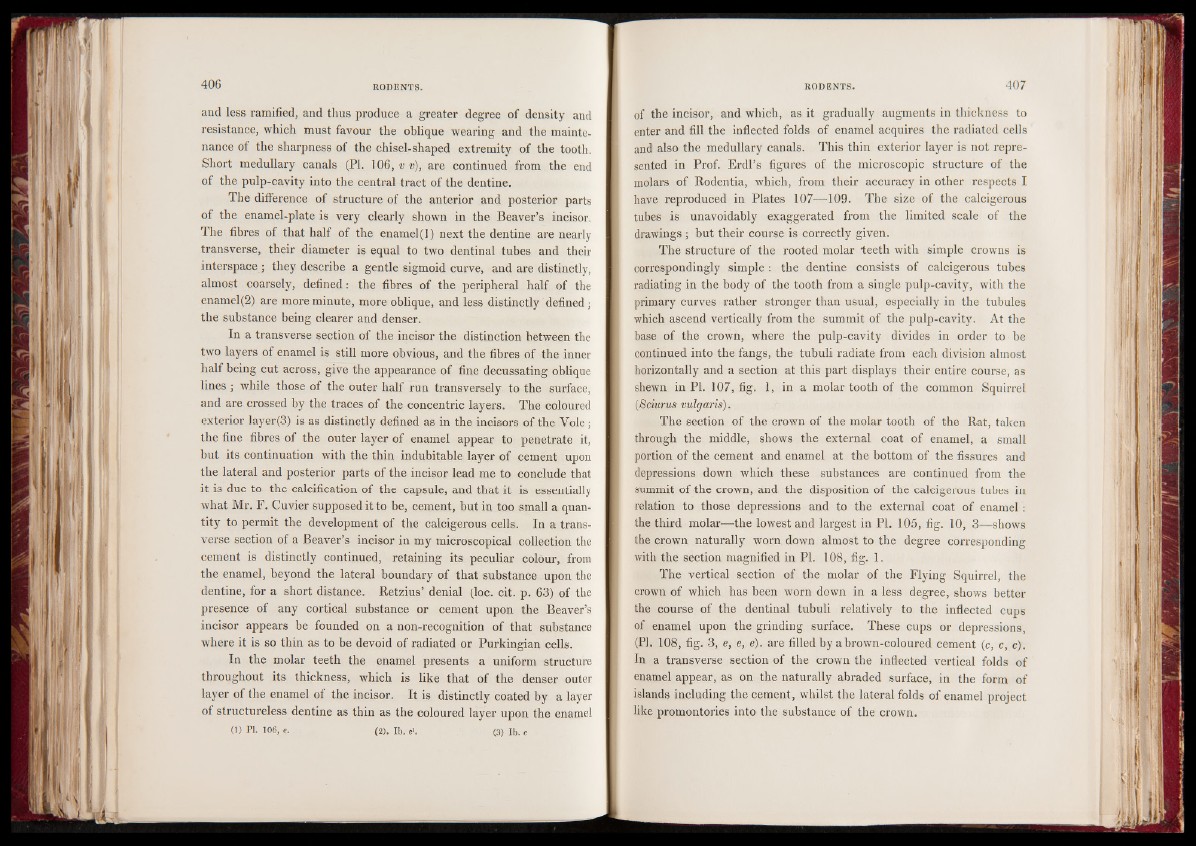
and less ramified, and thus produce a greater degree of density and
resistance, which must favour the oblique wearing and the maintenance
of the sharpness of the chisel-shaped extremity of the tooth.
Short medullary canals (PI. 106, v v), are continued from the end
of the pulp-cavity into the central tract of the dentine.
The difference of structure of the anterior and posterior parts
of the enamel-plate is very clearly shown in the Beaver’s incisor.
The fibres of that half of the enamel(l) next the dentine are nearly
transverse, their diameter is equal to two dentinal tubes and their
interspace ; they describe a gentle sigmoid curve, and are distinctly,
almost coarsely, defined: the fibres of the peripheral half of the
enamel(2) are more minute, more oblique, and less distinctly defined;
the substance being clearer and denser.
In a transverse section of the incisor the distinction between the
two layers of enamel is still more obvious, and the fibres of the inner
half being cut across, give the appearance of fine decussating oblique
lines ; while those of the outer half run transversely to the surface,
and are crossed by the traces of the concentric layers. The coloured
exterior layer(3) is as distinctly defined as in the incisors of the Vole ;
the fine fibres of the outer layer of enamel appear to penetrate it,
but its continuation with the thin indubitable layer of cement upon
the lateral and posterior parts of the incisor lead me to conclude that
it is due to the calcification of the capsule, and that it is essentially
what Mr. F. Cuvier supposed it to be, cement, but in too small a quantity
to permit the development of the calcigerous cells. In a transverse
section of a Beaver’s incisor in my microscopical collection the
cement is distinctly continued, retaining its peculiar colour, from
the enamel, beyond the lateral boundary of that substance upon the
dentine, for a short distance. Retzius’ denial (loc. cit. p. 63) of the
presence of any cortical substance or cement upon the Beaver’s
incisor appears be founded on a non-recognition of that substance
where it is so thin as to be devoid of radiated or Purkingian cells.
In the molar teeth the enamel presents a uniform structure
throughout its thickness, which is like that of the denser outer
layer of the enamel of the incisor. It is distinctly coated by a layer
of structureless dentine as thin as the coloured layer upon the enamel
(1) PI. 106, e. (2). Ib. e>. (3) lb. c
of the incisor, and which, as it gradually augments in thickness to
enter and fill the inflected folds of enamel acquires the radiated cells
and also the medullary canals. This thin exterior layer is not represented
in Prof. Erdl’s figures of the microscopic structure of the
molars of Rodentia, which, from their accuracy in other respects I
have reproduced in Plates 107—109. The size of the calcigerous
tubes is unavoidably exaggerated from the limited scale of the
drawings ; but their course is correctly given.
The structure of the rooted molar teeth with simple crowns is
correspondingly simple : the dentine consists of calcigerous tubes
radiating in the body of the tooth from a single pulp-cavity, with the
primary curves rather stronger than usual, especially in the tubules
which ascend vertically from the summit of the pulp-cavity. At the
base of the crown, where the pulp-cavity divides in order to be
continued into the fangs, the tubuli radiate from each division almost
horizontally and a section at this part displays their entire course, as
shewn in PI. 107, fig. 1, in a molar tooth of the common Squirrel
(Sciurus vulgaris).
The section of the crown of the molar tooth of the Rat, taken
through the middle, shows the external coat of enamel, a small
portion of the cement and enamel at the bottom of the fissures and
depressions down which these substances are continued from the
summit of the crown, and the disposition of the calcigerous tubes in
relation to those depressions and to the external coat of enamel :
the third molar—the lowest and largest in PI. 105, fig. 10, 3—shows
the crown naturally worn down almost to the degree corresponding
with the section magnified in PI. 108, fig. 1 .
The vertical section of the molar of the Flying Squirrel, the
crown of which has been worn down in a less degree, shows better
the course of the dentinal tubuli relatively to the inflected cups
of enamel upon the grinding surface. These cups or depressions,
(PI. 108, fig. 3, e, e, e). are filled by a brown-coloured cement (c, c, c).
In a transverse section of the crown the inflected vertical folds of
enamel appear, as on the naturally abraded surface, in the form of
islands including the cement, whilst the lateral folds of enamel project
like promontories into the substance of the crown.